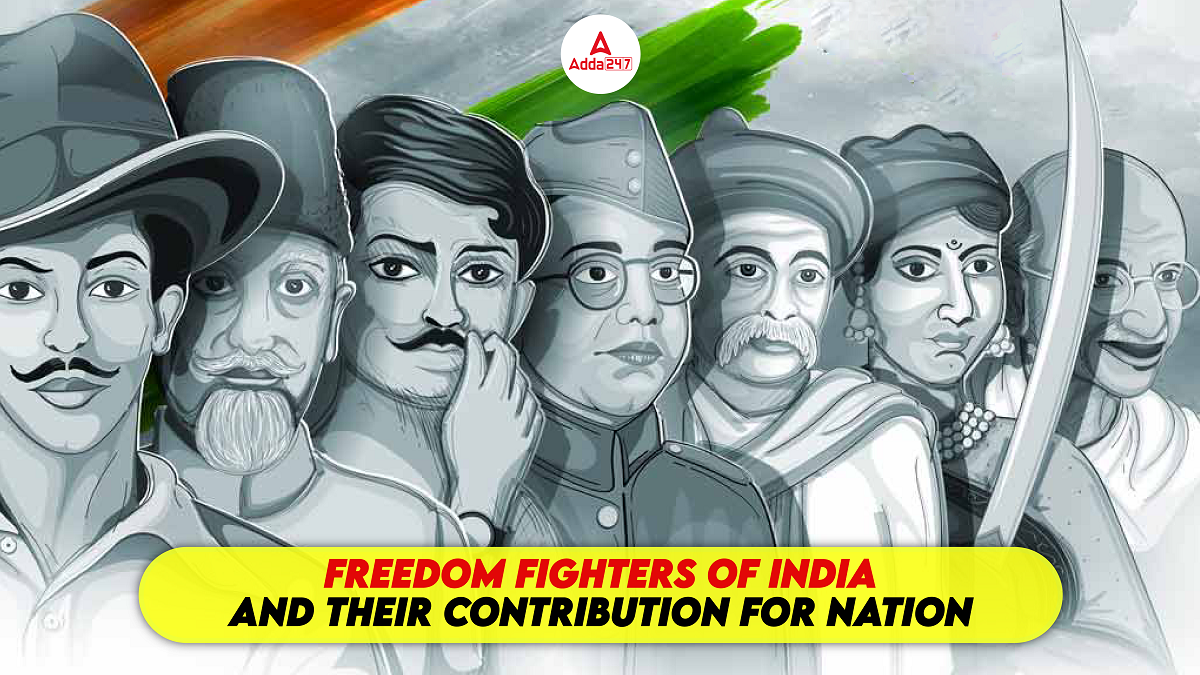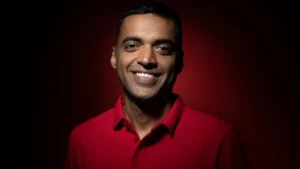The Indian independence movement was the combined effort of many people and groups from different backgrounds who worked to free India from the control of the British, French, and Portuguese. This is a list of well-known people who fought against foreign rule or are remembered for standing against it. The movement began in 1857 with the historic First War of Independence, also known as the Revolt of 1857.
Following independence, the Indian government recognized the name “freedom fighter” for individuals who participated in the movement. Let us have a look at some of the most important freedom fighters of Indian Independence movement:
Freedom Fighters of India
The history of India’s fight for Independence is adorned with the unwavering determination and sacrifices of countless freedom fighters. These individuals, driven by a fierce desire to break free from British colonial rule, dedicated their lives to securing India’s sovereignty. Through non-violent protests, civil disobedience and armed resistance, they challenged oppression and injustice, leaving an indelible legacy that continues to inspire the pursuit of freedom and justice around the world.
Freedom Fighters of India and Their Contribution
India’s struggle for independence from British rule was marked by the sacrifices and contributions of numerous freedom fighters. Their courage, determination, and unwavering commitment to the cause of freedom have left an indelible mark on the nation’s history. Here, we look at ten of the most prominent freedom fighters who played a pivotal role in India’s independence movement:
| Freedom Fighters | Contributions |
| Mohandas Karamchand Gandhi | Led the victorious struggle for India’s independence from British control; inspired civil rights movements globally. |
| Dr. B.R. Ambedkar | Chaired the committee that drafted the Constitution of India; Law and Justice Minister; inspired the Dalit Buddhist movement. |
| Dr. Rajendra Prasad | First President of India; key leader in Indian National Congress; imprisoned during Quit India and Salt Satyagraha movements. |
| Sardar Vallabhbhai Patel | First Deputy Prime Minister and Home Minister of India; known as “Unifying India”; commemorated by the Statue of Unity. |
| Jawaharlal Nehru | First Prime Minister of India; promoted parliamentary democracy, secularism, science, and technology; kept India non-aligned in the Cold War. |
| Bhagat Singh | Revolutionary who avenged an Indian nationalist’s death by killing a British policeman; became a martyr after his execution at age 23. |
| Pingali Venkayya | Designed the Swaraj Flag, which later became the Indian Flag; also a polyglot, lecturer, novelist, geologist, educationalist, and farmer. |
| Chandra Shekhar Azad | Reorganized the Hindustan Republican Association into the Hindustan Socialist Republican Association; signed pamphlets as “Balraj.” |
| Subhas Chandra Bose | Indian nationalist known as “Netaji”; allied with Nazi Germany and Imperial Japan during WWII; became a controversial figure. |
| Mangal Pandey | Played a key role in the events leading up to the 1857 Indian uprising; served as a sepoy in the British East India Company’s 34th Bengal Native Infantry; honored with a postage stamp and depicted in films. |
| Bakht Khan | Served as the military leader of the Indian independent forces in the Delhi region during the 1857 Rebellion against the East India Company. |
| Chetram Jatav | Participated in the Indian Rebellion of 1857; joined the mutiny in Soro, North-Western Provinces (now Uttar Pradesh); executed by being shot while tied to a tree. |
| Bahadur Shah Zafar | The twentieth and final Mughal Emperor of India; exiled to Rangoon, British-controlled Burma, in 1858 after participating in the 1857 Indian Mutiny. |
| Begum Hazrat Mahal | Regent of Awadh in 1857–1858; played a pivotal role in the Indian Rebellion of 1857’s uprising against the British East India Company. |
| Rani Laxmi Bai | Maharani consort of the Maratha princely state of Jhansi; key player in the 1857 Indian Rebellion; symbol of Indian nationalist opposition to the British Raj. |
Top-10 Freedom Fighters of India in Brief
Here is a brief overview of the freedom fighters of India, highlighting their significant contributions and roles in the nation’s struggle for independence and subsequent nation-building efforts:
1. Mohandas Karamchand ‘Mahatma’ Gandhi
The victorious struggle for India’s independence from British control was led by Indian lawyer, anti-colonial nationalist, and political ethicist Mohandas Karamchand Gandhi (Mahatma Gandhi), the father of the nation, who later served as an inspiration for movements for civil rights and freedom around the globe.
2. Dr. B R Ambedkar
Bhimrao Ramji Ambedkar was an Indian jurist, economist, social reformer, and political figure who served as the chairman of the committee that drafted the Constitution of India from the discussions in the Constituent Assembly. He also held the position of Law and Justice Minister in Jawaharlal Nehru’s first cabinet and, after renunciating Hinduism, served as an inspiration for the Dalit Buddhist movement.
3. Dr. Rajendra Prasad
Rajendra Prasad was an Indian politician, attorney, advocate for Indian independence, journalist, and academic who presided over the Republic of India from 1950 to 1962. During the Indian Independence Movement, he joined the Indian National Congress and rose to prominence as a leader from the states of Bihar and Maharashtra. Prasad, a devotee of Mahatma Gandhi, was detained by British authorities during the Quit India campaign in 1942 and the Salt Satyagraha in 1931.
4. Sardar Vallabhbhai Patel
The first Deputy Prime Minister of India and the country’s first Home Minister, Vallabhbhai Jhaverbhai Patel, also known as Sardar, was an Indian lawyer, prominent political figure, lawyer, and statesman who served from 1947 to 1950. He is sometimes referred to as “Unifying India.” At a cost of USD 420 million, the Indian government built the Statue of Unity, the tallest statue in the world, which was dedicated to him on October 31, 2018. Its height is roughly 182 metres (597 feet).
5. Jawaharlal Nehru
A major personality in India throughout the middle of the 20th century, Jawaharlal Nehru was an anti-colonial patriot, secular humanist, social democrat, and author. In the 1930s and 1940s, Nehru was a key figure in the Indian nationalist movement. He was the first prime minister of India after its independence in 1947, holding the position for 16 years. Nehru greatly influenced India’s development into a modern nation in the 1950s by promoting parliamentary democracy, secularism, science, and technology. He kept India out of the Cold War’s two blocs in foreign affairs. He is a well-known novelist whose writings, including The Discovery of India and Letters from a Father to His Daughter, were written while he was incarcerated.
6. Bhagat Singh
Bhagat Singh, a famous revolutionary from India, took part in the mistaken murder of a young British policeman as vengeance for the killing of an Indian nationalist. Later, he participated in a largely symbolic bombing of the Delhi Central Legislative Assembly and went on a hunger strike while imprisoned. As a result of sympathetic press coverage in Indian-owned newspapers, he became well-known in the Punjab region, and after his execution at age 23, he was revered as a martyr and folk hero in Northern India.
7. Pingali Venkayya
Gandhian and Indian liberation fighter Pingali Venkayya. He is credited for creating the Swaraj Flag, which Mahatma Gandhi used during the Indian independence movement and which Surayya Tyabji eventually changed into the Indian Flag. He was also a polyglot, lecturer, novelist, geologist, educationalist, and farmer.
8. Chandra Shekhar Azad
After the passing of the party’s founder, Ram Prasad Bismil, and three other important party leaders, Roshan Singh, Rajendra Nath Lahiri, and Ashfaqulla Khan, Chandra Shekhar Tiwari, also known as Chandra Shekhar Azad, reorganised the Hindustan Republican Association (HRA) under its new name, Hindustan Socialist Republican Association (HSRA). His parents were Sitaram Tiwari and Jagrani Devi, and he was from Badarka, Unnao in Uttar Pradesh. As the commander in chief of the HSRA, he frequently signed pamphlets under the alias “Balraj.”
9. Subhas Chandra Bose
However, his wartime alliances with Nazi Germany and Imperial Japan left a legacy plagued by authoritarianism, anti-Semitism, and military failure. Subhas Chandra Bose was an Indian nationalist whose rejection of British rule in India made him a hero among Indians. Early in 1942, German and Indian officials in the Special Bureau for India in Berlin and Indian soldiers of the Indische Legion addressed Bose as Netaji for the first time. It is presently utilised all throughout India.
10. Chittaranjan Das
During the Indian independence movement and the period of British colonial administration in India, Chittaranjan Das, also known as Deshbandhu, was a freedom fighter, political activist, and lawyer. He also founded and served as the leader of the Swaraj Party in undivided Bengal. He goes by the initials C. R. Das. In addition to several articles and essays, he was closely affiliated with a number of literary clubs and composed poetry.
Indian Rebellion of 1857: The Revolt of 1857
The Rebellion of 1857 or the Revolt of 1857 is known as the first war of Independence. Here are some of the most important leaders of the 1857 revolt:
Mangal Pandey
An important role was played by an Indian soldier named Mangal Pandey in the events that took place just before the 1857 Indian uprising began. He served as a sepoy (infantryman) in the British East India Company’s 34th Bengal Native Infantry (BNI) regiment. The Indian government released a postage stamp in his honour in 1984. A number of film projects have also depicted his life and deeds.
Bakht Khan
During the Indian Rebellion of 1857 against the East India Company, General Bakht Khan served as the military leader of the Indian independent forces in the Delhi region.
Chetram Jatav
Freedom warrior Chetram Jatav took part in the Indian Rebellion of 1857. On May 26, 1857, in the North-Western Provinces’ Soro area of Eta, he joined the mutiny (now Uttar Pradesh). They were shot while being tied to a tree.
Bahadur Shah Zafar
Bahadur Shah II, the twentieth and final Mughal Emperor of India, was born Mirza Abu Zafar Siraj-ud-din Muhammad. After being found guilty of multiple charges stemming from his participation in the Indian Mutiny of 1857, the British deported him to Rangoon in British-controlled Burma in 1858.
Begum Hazrat Mahal
The second wife of Nawab of Awadh Wajid Ali Shah and the regent of Awadh in 1857–1858 was Begum Hazrat Mahal, also referred to as the Begum of Awadh. She is renowned for playing a pivotal part in the Indian Rebellion of 1857’s uprising against the British East India Company.
Rani Laxmi Bai
As the wife of Maharaja Gangadhar Rao, Lakshmibai served as the Maharani consort of the Maratha princely state of Jhansi from 1843 until 1853. She was a key player in the 1857 Indian Rebellion and became a stand-in for Indian nationalists’ opposition to the British Raj.



 What was the Old Name of Goa? Know About...
What was the Old Name of Goa? Know About...
 Top-10 Most Searched Words in 2025, Chec...
Top-10 Most Searched Words in 2025, Chec...
 Deepinder Goyal Tops Hurun Rich List 202...
Deepinder Goyal Tops Hurun Rich List 202...







